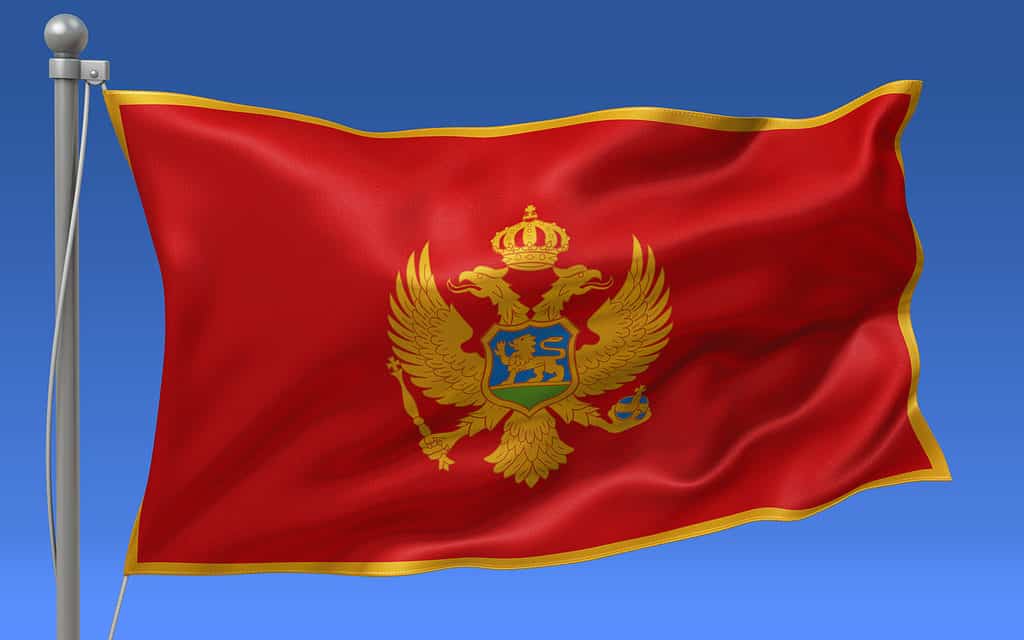Montenegro is a country located in the southeastern part of Europe. Bosnia and Herzegovina borders the nation on the north, while Kosovo borders it on the east, Serbia borders it on the northeast, and Croatia borders it on the northwest. Podgorica serves as the country’s administrative center, but Cetinje, its former capital and largest city, serves as its cultural hub. In the latter half of the 15th century, the nation was given the name Montenegro for the first time. Coincidentally, the country’s native name Crna Gora and its official name can be translated to mean the same thing – “black mountain/hill,” in reference to Mount Lovćen.
The country is known for its mountains, but it is even more famous for its beaches which attract a lot of tourists, especially in the summer. Apart from its beautiful beaches and mountains, the country can also be recognized by its flag. The country’s history is rich, and it is, to an extent, reflected in its flag. Please keep reading to learn about the country’s history and how it affected the flag choice, as well as the meaning and symbolism of the flag.
Characteristics of Montenegro
Montenegro is not a particularly large country, with a population of less than 650,000 spread over 13,810 square kilometers (5,332 square miles), making it the seventh smallest country in Europe. The name “Montenegro” literally translates to “black mountain,” and as mentioned earlier, even the country’s native name translates to black mountain. This name is in reference to Mount Lovćen, which is located in southwestern Montenegro and served as a stronghold for the country during centuries of altercations with the Turks. The nation, which is made up of mountains and plains, is situated on the Adriatic coast of the Balkan Peninsula, and the country’s diverse terrains have made it popular for tourists around the world.
Present-day Montenegro was mostly populated by people referred to as Illyrians before the Slav peoples arrived in the Balkans in the sixth and seventh centuries CE. The area fell under Ottoman rule, and after the first World War, it became a part of Yugoslavia. However, the kingdom of Yugoslavia broke apart, and Montenegro and Serbia joined to form a federation. The nation is now a parliamentary republic that separated from Serbia in June 2006. The executive, legislative, and judicial branches of Montenegro’s government are independent. The President is the head of state and is directly elected for a five-year term. Montenegro’s unicameral parliament is presided over by a prime minister. Its judicial system comprises a supreme court with life-term justices and a constitutional court with five judges serving nine-year terms.
The primary ethnic groups in the country are Montenegrins and Serbs, and the difference between these two groups is not very obvious because of their intertwined pasts. Despite having existed for centuries, through the Ottoman period, these ethnic groups retained most of their culture and religious practices. Montenegrins evolved unique traits and institutions during the protracted split from Serbia. However, the most practiced religion in the country is Christianity, with the most popular denomination being the Serbian Orthodox Church. The Montenegrin Orthodox Church was recently founded, and it is only followed by a minority of Montenegrins. Roman Catholicism is also another denomination of Christianity practiced by the people of Montenegro. The second most practiced religion in the nation is Islam, which accounts for 19% of the population and places the country as the sixth highest Muslim-practicing population in Europe.
History of the Flag of Montenegro

Montenegro’s current flag was designed when the country was still a part of the State Union of Serbia and Montenegro.
©iStock.com/sommersby
Although the current flag of Montenegro is one of the more recent in Europe, its history dates all the way back to the Middle Ages. Its origins are in the traditional regional heraldry, but developments throughout the years have ensured that it now also represents the current nation and the region’s historical heritage. The military flag of Serbia during the Battle of Kosovo inspired Montenegro’s earliest known flag, which had a solid crimson field with a white cross in the center. It was abandoned in 1852 after the cross was changed to a white eagle resembling the one on the current flag of Montenegro.
After the first World War, Montenegro merged with a number of its neighbors, and as a result, it did not have its own flag. The current flag was designed while the country was still a part of the State Union of Serbia and Montenegro in 2004, but it was retained even after the country got its independence in 2006.
Meaning and Symbolism of the Flag of Montenegro

The eagle, a typical Byzantine Empire emblem, appears on the Montenegro flag to signify the country’s historical ties to that empire.
©iStock.com/Nabil Kamara
One of the newest flags in Europe, the flag of Montenegro, features a red field with a gold border and the country’s coat of arms in the middle. An orb and scepter are held in a golden eagle’s talons with two heads appearing on the coat of arms. The eagle is crowned, and a lion-themed shield is positioned over its chest. The eagle, a typical Byzantine Empire emblem, appears on the Montenegro flag to signify the country’s historical ties to that empire. Because of its historical significance as an ecclesiastical principality, the lion is a traditional representation of religious authority.
Up Next:
Red Flag With Green Star: Morocco Flag History, Meaning, and Symbolism
White, Green, and Red Flag: Bulgaria Flag History, Meaning, and Symbolism
29 Different Countries with Red, White, and Blue Flags
The photo featured at the top of this post is © iStock.com/Juan Ignacio Rodríguez Moronta
Thank you for reading! Have some feedback for us? Contact the AZ Animals editorial team.






